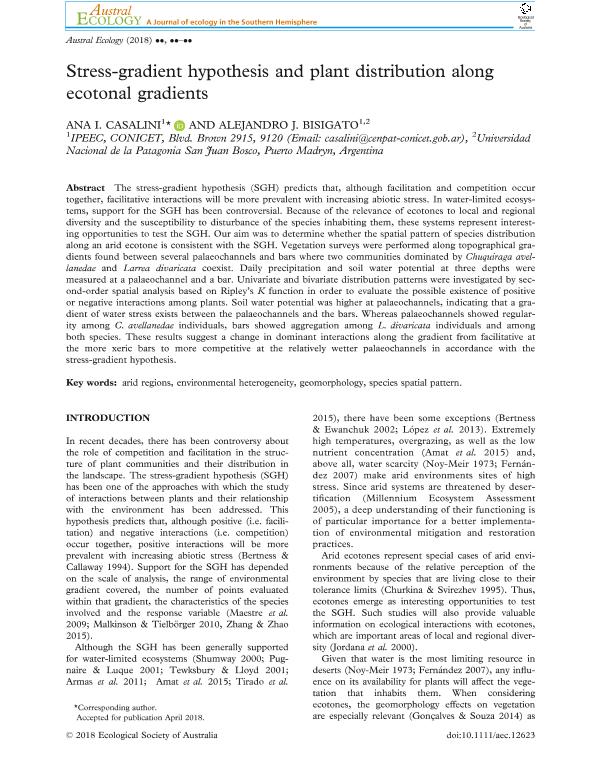Mostrar el registro sencillo del ítem
dc.contributor.author
Casalini, Ana Isabel

dc.contributor.author
Bisigato, Alejandro Jorge

dc.date.available
2019-11-07T21:28:18Z
dc.date.issued
2018-11
dc.identifier.citation
Casalini, Ana Isabel; Bisigato, Alejandro Jorge; Stress-gradient hypothesis and plant distribution along ecotonal gradients; Wiley Blackwell Publishing, Inc; Austral Ecology; 43; 7; 11-2018; 807-816
dc.identifier.issn
1442-9985
dc.identifier.uri
http://hdl.handle.net/11336/88260
dc.description.abstract
The stress-gradient hypothesis (SGH) predicts that, although facilitation and competition occur together, facilitative interactions will be more prevalent with increasing abiotic stress. In water-limited ecosystems, support for the SGH has been controversial. Because of the relevance of ecotones to local and regional diversity and the susceptibility to disturbance of the species inhabiting them, these systems represent interesting opportunities to test the SGH. Our aim was to determine whether the spatial pattern of species distribution along an arid ecotone is consistent with the SGH. Vegetation surveys were performed along topographical gradients found between several palaeochannels and bars where two communities dominated by Chuquiraga avellanedae and Larrea divaricata coexist. Daily precipitation and soil water potential at three depths were measured at a palaeochannel and a bar. Univariate and bivariate distribution patterns were investigated by second-order spatial analysis based on Ripley's K function in order to evaluate the possible existence of positive or negative interactions among plants. Soil water potential was higher at palaeochannels, indicating that a gradient of water stress exists between the palaeochannels and the bars. Whereas palaeochannels showed regularity among C. avellanedae individuals, bars showed aggregation among L. divaricata individuals and among both species. These results suggest a change in dominant interactions along the gradient from facilitative at the more xeric bars to more competitive at the relatively wetter palaeochannels in accordance with the stress-gradient hypothesis.
dc.format
application/pdf
dc.language.iso
eng
dc.publisher
Wiley Blackwell Publishing, Inc

dc.rights
info:eu-repo/semantics/openAccess
dc.rights.uri
https://creativecommons.org/licenses/by-nc-sa/2.5/ar/
dc.subject
Arid regions
dc.subject
Environmental heterogeneity
dc.subject
Geomorphology
dc.subject
Species spatial pattern
dc.subject.classification
Otras Ciencias Naturales y Exactas

dc.subject.classification
Otras Ciencias Naturales y Exactas

dc.subject.classification
CIENCIAS NATURALES Y EXACTAS

dc.title
Stress-gradient hypothesis and plant distribution along ecotonal gradients
dc.type
info:eu-repo/semantics/article
dc.type
info:ar-repo/semantics/artículo
dc.type
info:eu-repo/semantics/publishedVersion
dc.date.updated
2019-10-22T15:52:37Z
dc.journal.volume
43
dc.journal.number
7
dc.journal.pagination
807-816
dc.journal.pais
Reino Unido

dc.journal.ciudad
Londres
dc.description.fil
Fil: Casalini, Ana Isabel. Consejo Nacional de Investigaciones Científicas y Técnicas. Centro Científico Tecnológico Conicet - Centro Nacional Patagónico. Instituto Patagónico para el Estudio de los Ecosistemas Continentales; Argentina
dc.description.fil
Fil: Bisigato, Alejandro Jorge. Consejo Nacional de Investigaciones Científicas y Técnicas. Centro Científico Tecnológico Conicet - Centro Nacional Patagónico. Instituto Patagónico para el Estudio de los Ecosistemas Continentales; Argentina. Universidad Nacional de la Patagonia "San Juan Bosco"; Argentina
dc.journal.title
Austral Ecology

dc.relation.alternativeid
info:eu-repo/semantics/altIdentifier/doi/http://dx.doi.org/10.1111/aec.12623
dc.relation.alternativeid
info:eu-repo/semantics/altIdentifier/url/https://onlinelibrary.wiley.com/doi/abs/10.1111/aec.12623
Archivos asociados
